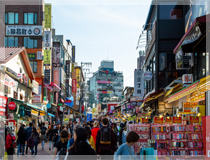About Seoul

Seoul, the capital city of the Republic of Korea, has been the center of the country for the long period of its own history from the prehistoric era to the present day. Seoul was the capital of an ancient dynasty Baekje, from 18 BC to 475 AD. After a long time had passed, Seoul has been serving again as the capital of the country since the Joseon Dynasty in 1394 until now for more than 600 years. From the Joseon Dynasty (1392) to the present time, Seoul has gone through many changes and developments as the capital of Korea. Based on its long history and tradition, Seoul has been preserving its unique, beautiful cultural heritage and it is evolving into a highly advanced city through spectacular economic growth.

The Republic of Korea is surrounded by seas on three sides, and Seoul is in the west of the country, with Hangang River Stretching across it. A number of bridges are connecting the southern and northern part of the city, boasting beautiful sceneries of their own. Also, Seoul, the heart of the nation and home to 10 million national and foreign residents, is a world-class city where contemporary lifestyle meets long-standing history. Seoul houses 266 cultural properties including five grand royal palaces, and is also a proud epicenter of the “Korean Wave” pop culture that is adored by many. Every corner of the city is packed with friendly residents and extraordinary restaurants, teeming with modern streetscapes and dashing natural landscapes. Seoul indeed is a place of boundless discoveries, where no two visits are alike.
More about Seoul Transport in Seoul Enjoying Seoul Visit Seoul
The Gyeongbokgung Palace
Built in 1395, Gyeongbokgung Palace is also commonly referred to as the Northern Palace because its location is furthest north when compared to the neighboring palaces of Changdeokgung (Eastern Palace) and Gyeonghuigung (Western Palace) Palace. Gyeongbokgung Palace is arguably the most beautiful, and remains the largest of all five palaces.
More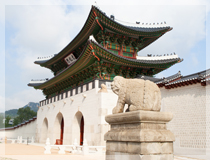
Namsan Seoul Tower
Namsan Seoul Tower was the first tower-type tourism spot in Korea. The top of the tower is at almost 480 meters above sea level, including Namsan Mountain (243m) and the tower’s own height (236.7m), making it one of the tallest towers in Asia. The tower was first established as a broadcasting tower to send out TV and radio signals in 1969. As of now, it has become one of the representative landmarks and multi-cultural venues in Seoul.
More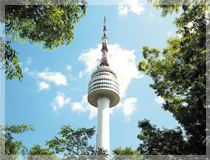
Bukchon Hanok Village
Surrounded by Gyeongbokgung Palace, Changdeokgung Palace and Jongmyo Shrine, Bukchon Hanok Village is home to hundreds of traditional houses, called hanok, that date back to the Joseon Dynasty. Today, many of these hanoks operate as cultural centers, guesthouses, restaurants and tea houses, providing visitors with an opportunity to experience, learn and immerse themselves in traditional Korean culture.
More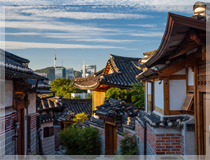
Cheonggyecheon Stream
Cheonggyecheon is a 10.9-kilometre-long (6.8 mi), modern public recreation space in downtown Seoul, South Korea. The massive urban renewal project is on the site of a stream that flowed before the rapid post-war economic development caused it to be covered by transportation infrastructure.
More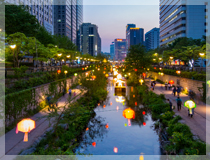
Dongdaemun Design Plaza (DDP)
Dongdaemun Design Plaza (DDP) has a meaning of Dream, Design, and Play. It holds various exhibitions, fashion shows, forums, conferences, and other domestic and international events. Registration for touring the architecture is available on-site and other event schedules and kid program information are available on the website.
More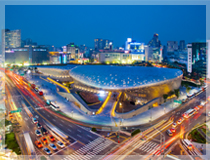
Myeong-dong
Myeong-dong is one of the primary shopping districts in Seoul. Many brand name shops and department stores line the streets and alleys. Unlike Namdaemun or Dongdaemun, many designer brands are sold in Myeong-dong. In addition, several major department stores have branches here.
More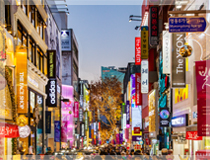
Lotte World Tower
Lotte World Tower with 123 floors and 555M height is the world’s 5th tallest building. It consists of the world's largest indoor theme park, an outdoor amusement park called "Magic Island", an artificial island inside a lake linked by monorail, shopping malls, a luxury hotel, a Korean folk museum, sports facilities, and movie theaters.
More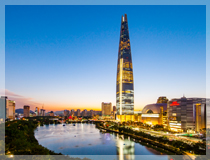
Insa-dong
Insa-dong, located in the heart of the city, is an important place where old but precious and traditional goods are on display. There is one main road in Insa-dong with alleys on each side. Within these alleys are galleries and traditional restaurants, teahouses, and cafes.
More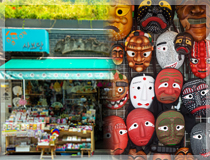
Hongdae
Hongdae is a neighborhood known for its youthful and romantic ambience, underground culture, and freedom of self-expression. Unique cafes, cozy galleries, accessory stores, fashion shops, live cafés and clubs, art markets, and gourmet eateries make this a popular hang-out for local youth and a fascinating place to walk around.
More